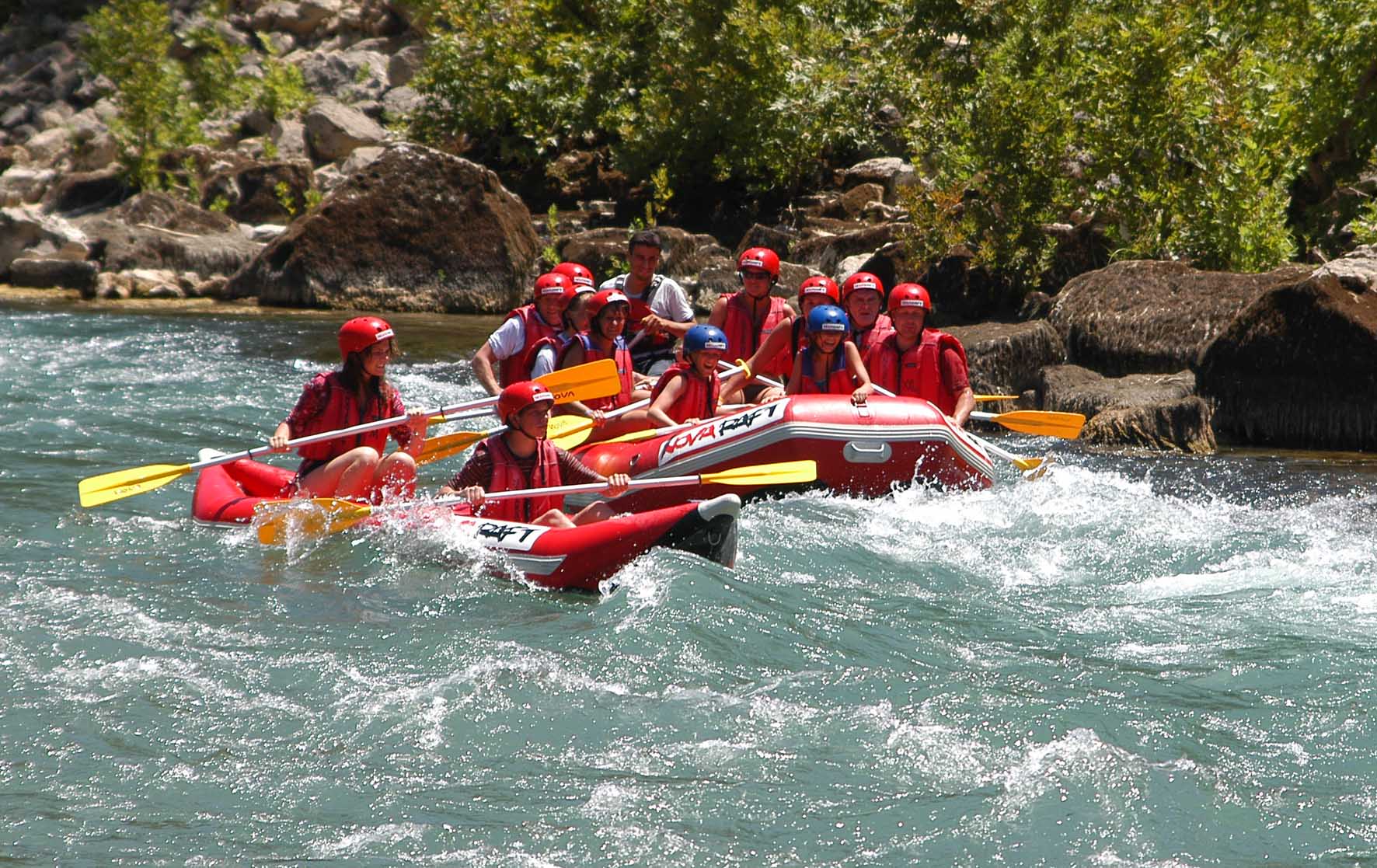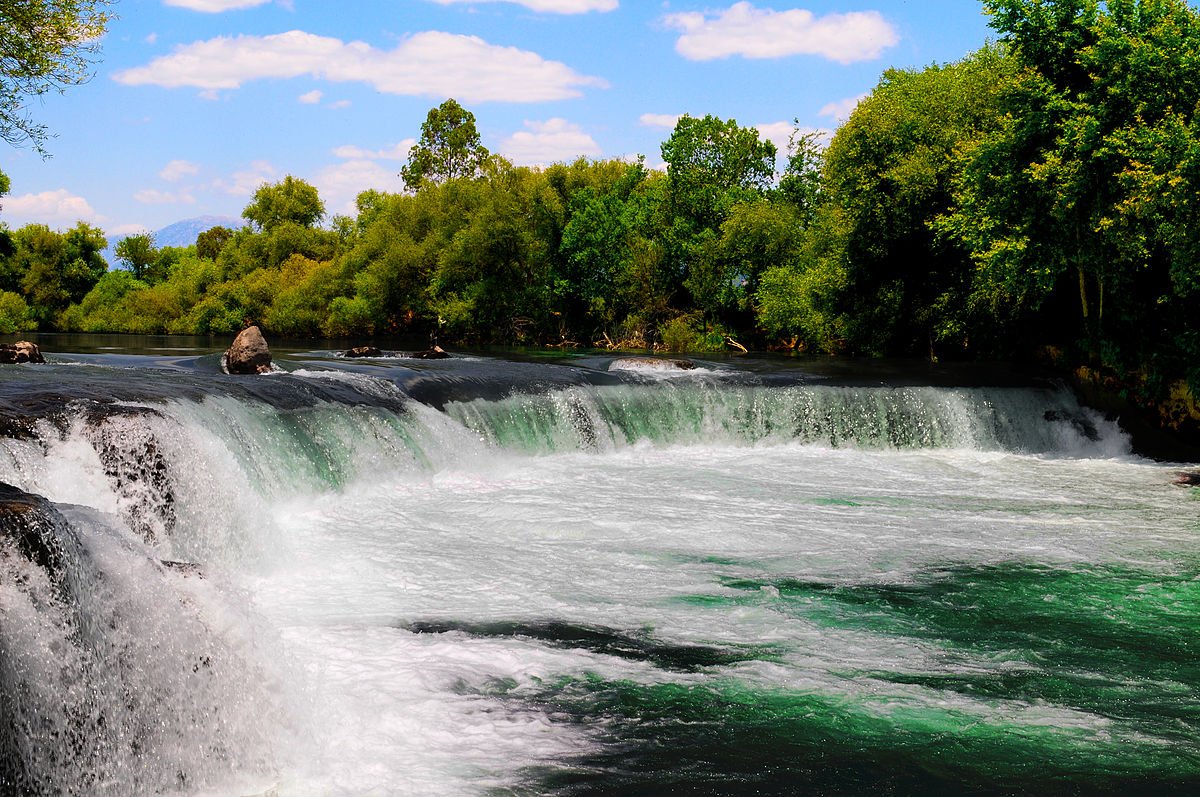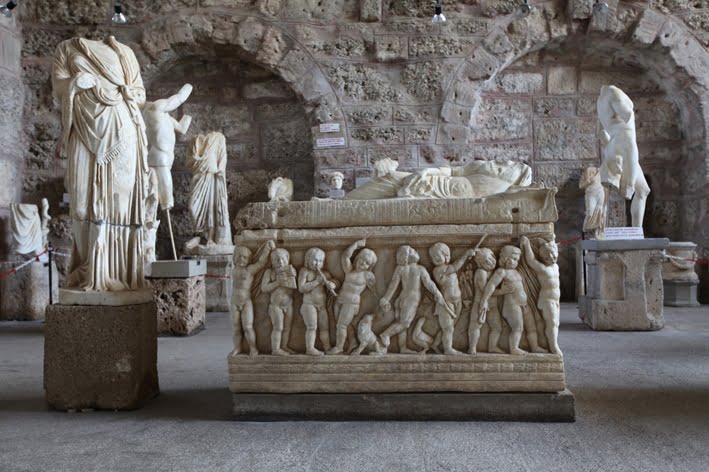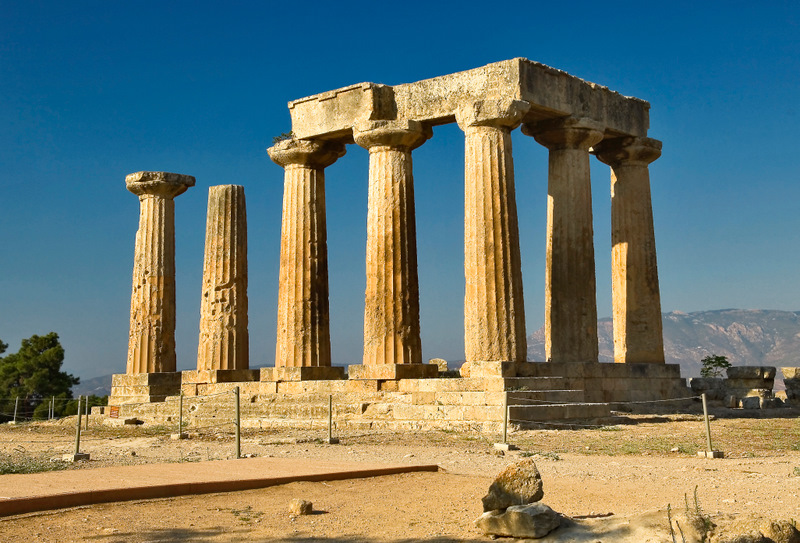Things to Know About Side – All About Side For Travel – Visit Side, Manavgat, Antalya, Turkey
Find out all you need about Side before travelling. See basic things to know concerning the Antalya Airport, weather and more. Prepare your trip now.
Turquoise sea,golden sand, light glistening onancient ruins… A dream paintedin sunset hues…
SİDE
Shaped by the cooling waters andsoft sands of the Mediterranean, heir to the riches of antiquity and child of the modern world, Side is the perfect destination, equally rich inancient treasures and the gems of contemporary entertainment, shopping and comfortable accommodation. Side is a superb choice for a holiday,whether your aim is to bath in sun,sea and sand, or to repose in harmony with nature under a soft, leafy canopy,or to explore the region’s unparalleled history, wandering mesmerised through the ruins of antiquity. Here sea and sky exist in perfect harmony, and where the waters meet the side of the peninsula, golden beaches give on to ancient ruins, cafes, superb restaurants and souvenir shops. Natural marvels such as Manavgat Waterfall and Köprülü Canyon National Park are easily accessible. It’s all here.


Manavgat Waterfall

Ruins of antiquity reflecting the spirit of time
The Temple of Apollo, anenchanting beauty spotted by therays of the sun
The Temple of Apollo stands atthe square marking the end of thecolumned road of ancient Side, its white marble columns backed by the blue of the sea proudly proclaimingits magnificence. Watching the sunsetand the colours deepening aroundthe magnificent structure devoted to Apollo, the god of light and the sun, is a profound and unforgettable experience. Apollo reserved a place nearby for his sister, Athena. The Temple devoted to Athena, the goddess of wisdom and warfare, is distinct with its Corinthian columns and capitals bearing marble blocks of an epistyle decorated with reliefs showing garlands of branchesand plants.The ancient Side was a centre ofcommerce, and the temples were builtnext to its harbour so that gods wouldprotect it. One of these is the templebelieved to have been devoted toMen, the God of Moon, which standsnext to the other temples. The peopleof Side worshipped Cybele and Menbefore Athena and Apollo. During theChristian Era the temples of the sacredfield were substituted for a basilica anda church. The basilica was built in 5thcentury AD, and the church was builtin the 8th or 9th century.
The god and goddess of Side, Apolloand Athena, adorned the coins mintedin here. The reverse, however, showedthe pomegranate, the symbol offertility and life represented by Cybeleand Athena. The word ‘Side’ itselfmeans pomegranate. Small and large,from coins to temples, these ancientobjects provide us highly valuableinformation regarding the history,beliefs, culture and daily life of Side. Gateway to the masterpieces ofantiquity Ancient Side welcomes its visitorsthrough the Main Gate, set betweentwo towers of the insurmountable citywalls, standing directly across fromthe monumental fountain. TheMain Gate dates to the 2nd century,and together with the horse shoeshaped, colonnaded courtyard it wasalso used for ceremonial processions.The monumental fountain across fromthe gate had three wide arches anda basin, and it was also built in the2nd century. It is the largest ancientfountain of Anatolia. Originally thestructure had three levels and it wasdecorated with marble cladding andreliefs, however at present only asingle level is standing and a fewdecorations of the pool can be seen.Manavgat River used to provide waterto the fountain through aqueducts,splendid examples of human ingenuityworking in tandem with the gifts ofnature. Sections of theaqueducts are stillvisible.Passing throughthe Main Gate andcourtyard there aretwo roads originally lined with corinthian columns: themain road that continues straightahead, and another leading off to the left.

The main road, which channelledthe social and cultural life of ancientSide, is lined with porticoes providingsheltered access to the shops andhouses, and passes through the agoraand city centre where a bathhouse,a theatre, and fountains once stood.The road eventually reaches the tip ofthe peninsula, site of the harbour andtemples, symbols of commerce andreligion. Agora where slaves famed for theirbeauty were sold After entering ancient Side andproceeding on the main road, thegroups of ruins on the left are fromthe bishopric basilica, surroundedwith columns, and the palace. A littlefurther down on the same road, againon the left is the commercial agorawhich is one of the two agorae of thecity. Apart from its traditional functionas a venue for commerce and a forumto discuss the political and economicsituation, the commercial agora ofSide assumed another function. In thefirst century BC a passage was builtthat connected the commercial agorato the theatre nearby, and both theagora and the theatre served as a slavemarket. In the middle of the agora,where slaves famed for their beautywere traded, used to stand a templedevoted to Fortuna, the goddess ofluck and trade, which had a round planlined with 12 columns with corinthiancapitals. The Agora was lined withporticos and large shops behind them.At one corner of the agora, next to thetheatre stood the latrina, the publictoilets of the city. The latrina, which was a decorated structure covered withdomes, and connected to the sewerslaid under the main road, is a proof ofexcellence in city planning in Antiquity.On the opposite side of the roadacross the agora stood the Roman Bathhouse from the 5th century,which now serves as a museum wheremagnificent sculptures, busts andsarcophagi are on permanent display. The Museum of Side, whichresembles Olympus, the home ofthe gods and goddesses The Museum of Side, with the statuesand figurines of gods and goddesseson display, seems like Olympus, thehome of the gods and goddesses. Herethe gods and goddesses of Olympuscompete with each other to whispermyth and legend in the ear of visitors.Zeus, Aphrodite, Ares, Nike, Hygeia,Asclepius, Apollo, Hermes, Dionysus,Heracles, Tyche and Athena – theheroes and heroines of the legends thatthey narrate themselve in the Museumof Side.The Museum of Side with its historicalbuilding and carefully displayedartefacts tells the story of the RomanPeriod of Side, and each section of theRoman Bathhouse has been arrangedas a separate gallery.The gardens of the museum, used to bethe part of the Gymnasium, houses thepermanent display of Seljuk Era gravestones, along with inscription tablets,friezes, and sarcophagi, parts of floormosaics, column bases, busts andsculpture from the Roman Period. Themost celebrated statue at the museumgarden is the statue of Nike, thegoddess of victory that salutes visitorsat the end of their journey throughtime.
Upon entering the courtyard of theMuseum, should you turn right insteadof proceeding to the garden, you willfind the exhibition halls right in frontof you. The first space is an open airexhibition containing reliefs of armsand a basalt capital from the LateHittite Period, as well as a splendidpond. The niches of the pond werebelieved to house the statues ofemperors, gods and goddesses. Thecentrepiece of the pond is a Romansundial.The closed exhibition galleries of theMuseum display glassware, coins, oillamps, figurines, jewellery, decorativeobjects, sarcophagi and statues.Besides the beautiful statues ofgods and goddesses, the Museum ofSide is renowned for the sarcophagidecorated with reliefs of multiple Erosfigurines, which are depicted walkingin procession, shoulder to shoulderaround the flat sides of the sarcophagi,and each figure playing a musicalinstrument, carrying fruit or drinkingwine. Garlands of fruit and roses,Nike figurines carrying wreaths anddates, and the heads of lions and bullscombined to make these sarcophagiutterly unforgettable. The 2nd century AD Statue of theThree Graces, depicting beauty,elegance, and fertility, is among themost precious ofthe museum’sholdings. TheThree Gracesare identified asHera, Aphroditeand Athena whobedazzle thegallery with theirelegance and might.

The exquisite Fountain ofVespasian and magnificent Theatreof Side After the museum the main roadcomes to the Vespasian Fountainwhich was built to honour the EmperorVespasian and used to be adornedwith beautiful sculptures, and themonumental gate with its singlearch. After the gate the theatrestands on the left in all its splendour.The Theatre of Side differscompletely from the type of theatremost frequently found in Anatolia,which was built by digging in a natural slope. As Side is situated in a flat land,its theatre was built over two storiedgalleries supported by arches andvaults. Architecturally, the Theatre of Sideresembles the magnificent Colosseumof Rome, and like the Colosseumit became an arena for gladiatorialgames. The high wall surrounding theorchestra protected spectators from thedangers of the games and it proves thatthe theatre was used for gladiator andanimal fights in the Late Roman Period.It is widely believed that wild animalswere kept in readiness for such fightsin the long and dark galleries under thescene leading to the agora.
With its three-level scene structurethe Theatre of Side was built in the2nd century to serve visual marvelsto approximately 17.000, and it wasdecorated with monumental columns,statues, and reliefs of mythologicalfigures. The flat earthen orchestradelineated with a water channelindicates that the theatre was usedduring Antiquity for water games.The theatre was used for open airreligious ceremonies in the 5th and6th centuries, and the prayers of thepeople of Side echoed to its walls.The ancient theatres symbolisedthe relationship between humans,animals and nature, and displayedthe experience gathered in thestruggle to cope with nature, oneof the most important aspects ofhuman experience in that period.They later became the centre of socialand cultural life. Some says that thetheatre first emerged in the festivalsheld to honour Dionysus. In tributeto the god of theatre, the Temple ofDionysus was built just to the leftafter the arena. The temple, whichdates to the 1st century BC, is frontedby the column brought from Egypt.Proceeding towards the sea on thecolumn lined road you see the ruinsof the Byzantine basilica on theright. Just before the harbour standsthe bathhouse built for the seamenarriving in Side and the remains ofhouses from the Byzantine Periodare visible. The wave breakers of theancient harbour can still be seen.
If you turn left at the Main Gate… After the Main Gate, the ruins of theByzantine basilica from the 5thcentury stand on the left side of thegrass covered road leading towards thesea. Across from the basilica are theruins of the smaller Byzantine churchfrom the 8th century. A side streetconnects the road to the state agora.The state agora (Structure M) is onthe seashore. It consists of a courtyardsurrounded by a colonnade of Ioniccolumns, porticoes, and three largehalls. The exquisite statues of Apollo,Ares, Asclepius, Hygiea, Hermes andNike, which are now on display at theMuseum of Side, used to stand in theseashell decorated niches of the agora.The original structure was two-storied.The central hall was the Emperor’s Hall,where ceremonies dedicated to theemperor took place. The halls flankingthe central hall are believed to havebeen used as a library or archives. Itis also known that the state agora wasalso used as a market place. The plinthstanding in the middle of the agora isbelieved to belong to a cross placedthere during the Byzantine Period.Apart from the ruins along those tworoads, the ruins of two necropoleiscan be seen behind the west and eastflanks of the city walls. Among theseruins there are column bases, marblesarcophagi, entablatures, and vaultedtombs.The domestic architecture of Side isalso interesting. Generally two storyhouses were built with timber frames filled with bricks standing on roughstone walls. These houses have beenconverted into comfortable pensions,restaurants offering delicious tastes,and shops selling hand-woven kilimsand carpets unique to Turkey, as wellas jewellery, accessories, decorativeitems, and clothing items. Side on the stage of history The generally accepted narrative,supported by Strabo, is that Sideappeared on the stage of history whenthe city was established by Cymeansemigrating south from İzmir on theAegean coast in the 7th century BC.However the studies regarding theorigins of the word “Side” concludedthat human settlement in Side begancenturies before this event. The word“Side” means pomegranate, andetymological studies indicated thatthe word neither belongs to Cymeanlanguage nor the generally useddialects of the Pamphylia region.The word is believed to belong to anancient Anatolian language used bythe local people who lived there beforethe arrival of Cymeans. According toEusebuis, a historian from the 3rdcentury BC, Side was a city ancienteven at that date, founded in 1405 BC.The Side of today was formed bythe great upheaval created by thecampaigns of Alexander the Great,and then the hegemony of Rome. TheMacedonian hegemony began in 334BC and continued until 301 BC. Thisshort period created a great changein Side, as in all lands that Alexanderbrought under his control. The locallanguage of Side used until the arrivalof Alexander was replaced by ancientGreek, the new language beingtaught by the teachers appointed byAlexander. Side, which used to beone of the ancient Anatolian cities,changed not only its religion, but alsoits form of state and regime. Before the domination of Macedonia, the citywas ruled by Persians for nearly twocenturies. After the death of Alexanderit was ruled by the Ptolemies (301-218 BC) and later by the Seleucids(218-189 BC), who arrived from Syria.During these periods Side was entitledto mint its own coinage, so it benefitedfrom a kind of autonomy.Side, in the 1st and 2nd centuries BC,was the largest port of Pamphylia, andwas home to the largest commercialfleet sailing in the Mediterranean.The city, enriched by trade and highlydeveloped intellectually, became acultural and educational centre. Side’sfame was such that the future King ofSeleucids, Antiochus III was sent toSide for education in 138 BC.In the 1st century BC, Romeintervened to protect Side frompiratical attacks, and the city cameunder Roman dominion, beginningthe most glorious period of its history.During the Roman Period, especiallyin the 2nd century AD, the city wasadorned with magnificent structures,beautified and vastly enriched.Unfortunately, as Roman authorityweakened in the 3rd century AD, tribesdescending from the north beganraiding Side. As raids continued inthe 4th century the city walls wererepaired, and later the inner city wallswere built, cutting the city in two toprotect the peninsula. Despite allthose measures the city began to looseits importance and wealth. Despitegaining importance as the seat of a bishop, the city was abandoned in the7th century following severe raids bypirates, Arab attacks and earthquakes.The present day settlement of Sidestarted with formation of SelimiyeVillage at the beginning of the 1900s,just next to the ancient Side.Excavations have unearthed muchof ancient Side, but substantial partsof the ancient city remain underthe earth. Most of the ruins visibletoday-the theatre, city walls, agorae,temples and other ruins that sosurprise and delight those with aninterest in ancient civilizations – datefrom the Roman Period. With an eyeon its discovered and still unknowntreasures, the whole peninsula wasdeclared a protected site. Manymysteries await exploration. Fantastic beaches competing withthe beauty of Cleopatra If you pass through the ancientcity in Side, a witness to the lovebetween Cleopatra and Antonius,you reach the seashore with longgolden sandy beaches. You must nowdecide whether to proceed east orwest. Whichever way you go, youwill be delighted, as was Cleopatrawhen she bathed here over twomillennia ago, by the splendidsandy beaches and pristinewaters. Melt into the sea,or go seeking the thrillof water sports!
Nearby attractions Sorgun Sorgun, where the forest meets thesea, is full of choice accommodationfacilities, horse riding centres, tree-shaded picnic areas, and restaurantsoffering delicious menus. Sorgun, faraway from the rush of city life, is asecluded spot where you can holidayin harmony with nature. Here youcan listen to your body’s need forrejuvenation or, should the fancy takeyou, ride a horse along quiet foresttrails and long empty beaches. Lake Titreyen Forest, lake and sea… These are thetriple delights that make Lake Titreyen(lit. the shimmering lake) unique,accompanied with golden beaches andnumerous accommodation and activityoptions! Lake Titreyen, surroundedby pine forest, derives its name fromits waters which shimmer with thebreeze. There are also horse riding centres which cater to all skill levels,providing training to beginners andenabling confident riders to explore thespectacular lake shore on their own. Manavgat Waterfall with TurquoiseWaters Manavgat Waterfall is a naturalwonder not far from Side. At thewaterfall giant plane trees extend theirbranches over the turquoise waters.The restaurants and cafes aroundallow you to enjoy the scenery whileenjoying glorious tastes. The waterfallis the upper limit of the boat tours onthe Manavgat River, and is just fourkilometres from Side by highway.Come and enjoy the calming sound offalling water and pleasing colours ofthe lower pond, accompanied by a cupof tea or the tasty local food!Two kilometres upstream to Manavgat,Küçük (Lesser) Waterfall offers several restaurants, cafes and teahouses.It provides a less busy, quieteratmosphere to its visitors. Oymapınar Dam; a spot oftranquillity The lake formed behind the OymapınarDam, with a depth of 100 metres, setat the foot of a 180-metre high rockychasm, has a thrilling landscape andtranquil atmosphere, attracting manyvisitors. The Oymapınar Dam is 18kilometres to Manavgat, and a fewhours spent there, taking a boat tour inthe tranquil lake, or a dinner enjoyed ina terrace with commanding view overthe enchanting landscape, would be anunforgettable experience. Ancient City of Seleucia; a pearl onthe edge of a chasm The road from Manavgat Waterfallleading to north towards the OymapınarDam and the ancient city of Seleuciafollows one of the river’s tributaries,and rises gradually, providing vistas ofthe Mediterranean Sea over the pineforests.The ancient city of Seleucia, which wasfounded by Seleucids from Syria, isperched on a chasm in the pine forestoverlooking the fantastic vista of Side,Sorgun and Lake Titreyen. Visitorswandering among the ancient ruins areaccompanied by the fantastic vista, therefreshing fragrance of pines, fantasticbird songs and sounds of falling water.Among the ruins are a remarkablemonumental gate with flanking towers,an agora surrounded with colonnadedporticoes, a hall believed to be thelibrary which hosts the Mosaic ofSeven Wise Men, an arched bathhousestructure, and the city walls whichentirely enclose the city on three sides, the fourth being protected bythe chasm. The outstanding ruins hereare the church, witness to the startof the Christian Era, the necropolisand the structure believed to be thebouleuterion or the odeon, with itswell preserved columns, windows andportal. Ancient City of Etenna; an unlikelyviewing terrace The ancient city of Etenna is 31kilometres north of Manavgat, andhas a beautiful location from which toenjoy the fantastic vista of Side andthe Mediterranean Sea. The Romanbathhouse, basilica, monumentaltombs, cisterns, city walls and agoraof the ancient city have reached to ourday. There is a spring in the bathhouseand it is still used by local villagersnearby. Köprülü Canyon National Park; the site of natural and cultural riches The Köprülü Canyon National Parkcovers a large area, approximately thirty seven thousand hectaresembracing numerous ancient ruins,a rich fauna and flora, and a rushingriver. It is one of those rare naturalspots which addresses all of yoursenses at once. The greenery of pinesand cypresses merge in the KöprülüCanyon with the energetic watersof Köprü Stream creating beautifullandscapes that invite the landscapephotographers.Visitors reach the park by taking theroad between Antalya and Manavgat,then following the exit for Taşağıl andBeşkonak. The road follows a beautifulstream, with forest on either side, tothe National Park. The National Park provides a rich selection of activities for discerning individuals amid its fantasticnature and ancient ruins. The optionsincluding trekking on the Ancient Roadfrom Oluk Bridge to Selge, rafting onthe Köprü Stream, one of the foremostroutes of the world, and camping on thehigher slopes of Mount Dedegöl. Alsovisitors may choose to swim in the coolwaters of Köprü Stream, enjoy seafoodat the restaurants overlooking the river,or have a picnic in the natural beauty ofthe National Park.Actually there are two canyons andtwo ancient bridges spanning those canyons in the Köprülü Canyon NationalPark: the Büğrüm Bridge over KocadereStream, and Oluk Bridge over Köprü Stream which lends its name to theNational Park. Each of the bridges, giftsfrom the Romans, have single archspans; the Oluk Bridge is still in use.The traces of ancient road providingaccess to Selge can be seen after theBüğrüm Bridge. The road climbingthrough hairpin bends towards the cityresembles in some sections a stairwaywith low steps. In the National Park,besides the ruins of the ancient city ofSelge, and the bridges, the ruins of achapel, an aqueduct, and the garrisontower are worth a visit. The ruins of the6th century AD chapel is on the roadleading toward Selge, between Olukand Büğrüm bridges. The garrisontower is about 700 metresfrom Oluk Bridge on a locationcommanding the ancient road,canyons and bridges. The ruinsof the aqueducts supplyingwater to the two-storeystructure can also beseen.
*Selge, the City of Lilies The road into the hills lays before youall beautiful vistas of Köprülü Canyon,and passes over the Oluk Bridge, andafter 13 kilometres finally reachesthe ancient city of Selge. Selge usedto be a regular stop-over for traders,who broke their hurried journeys toadmire its fantastic scenery, lilies,healing plants, wide forests and wine.Today its fantastic landscape and ruinsattract visitors from all over the globe.Strabo wrote that the Dorians firstsettled in Selge at the end of 2000BC. The second settlement was bythe Rhodians in the beginning of 7thcentury BC. Selge was the first coin-minting city of Pisidia, and the first realevidence of the history of Selge wasthese coins minted in 5th century BC.Selge had two agorae, and an activetrading life brought it wealth. Duringtowards the end of the Roman Period itlost its importance in trade, weakenedand collapsed.The ruins of the ancient city arenow combined with the present dayAltınkaya Village. The ruins of citywalls built by warlike people of thecity, and the theatre which used tobe the centre of the social life, areimmediately visible on arrival at thecity. Other ruins of Selge include theTemple of Zeus, agorae, colonnadedroad, bathhouse, cisterns andbasilicas. How to go? After reaching Antalya by road, airor sea, a 70 kilometres road journeyfrom central Antalya to east towardsManavgat and Alanya would bringvisitors to Side, which is on the Antalya-Alanya highway. Side couldalso be reached via Manavgat. Side is7 kilometres to Manavgat and regularminibus services are available betweenManavgat and destinations such asSide, Sorgun, and Manavgat Waterfall,which are renowned for their naturalbeauty and history.Today the modern centre of Side,and the ancient city on the peninsulaare merged together, and while thedistance is short enough to walk, there is a regular trackless-train service forthose who do not want to walk underthe heat. Where to stay? Side and nearby towns such asKumköy, Sorgun and Lake Titreyen,are full of attractive hotels set infantastic nature. Motels, pensions,holiday resorts, and apartmenthotels are among the comfortableaccommodation options in Side.
Do not leave Side unless you have * watched the sunset at the Temple of Apollo with its glorious columns,* visited the Museum of Side which houses one of the richestarchaeological collections of Turkey,* visited Manavgat Waterfall and enjoyed the thrills of rafting in the Köprülü Canyon National Park,* enjoyed a trekking, a climb, or a jeep safari at the Taurus Mountains adorned with colourful wild flowers,* enjoyed swimming, diving, or joining a boat trip to explore the Mediterranean Sea,* tasted local food at restaurants with a sea view. We hope you have made the right choice…
Important Phones and Web Addresses
Governorship of Antalya
(+90 242) 243 97 91-93-94
www.antalya.gov.tr
Antalya Provincial Directorate of Culture and Tourism
(+90 242) 247 76 60
www.antalyakulturturizm.gov.tr
Antalya Tourism Information Office
(+90 242) 247 76 60
Antalya Airport
(+90 242) 310 55 00 (Pbx)-330 3600
www.celebi-ic.com/tr
www.aytport.com.tr
Antalya Coach Terminus
(+90 242) 331 12 50
TÜRSAB (Association of TurkishTravel Agencies)
(+90 242) 243 19 96
www.tursab.org.tr
Manavgat District Governorship
(+90 242) 746 10 04
Side Tourism Information Office
(+90 242) 753 12 65
Museum of Side
(+90 242) 753 10 06
Manavgat Municipality
(+90 242) 746 10 82
Side Municipality
(+90 242) 753 10 13
TÜRSAB Side-Manavgat Regional Administrative Council
(+90 242) 753 35 61
Manavgat State Hospital
(+90 242) 746 11 17
Side State Hospital
(+90 242) 753 12 21
Health Emergency : 112
Police: 155
Gendarmerie: 156
Fire: 110 45
Cultural Heritage is Fragile
The world’s cultural heritage is like a bigpuzzle. Each monument, each object, isan irreplaceable part of the overall picturewhich gives us insight into our origins,our development and our lives today. Ithelps us to understand and appreciateother cultures. Each discovery, each newinterpretation adds to the puzzle andmakes the picture clearer. We must ensurethe protection of every single piece today,so that future generations may have theopportunities to enjoy the puzzle.Many people are not aware that ourcultural heritage is under stress fromnatural disasters such as earthquakes andfloods, and from slower acting processessuch as pollution or human actions.Even the most innocent gestures suchas collecting ancient pieces of pottery ormosaics as souvenirs have a destructiveimpact if repeated by thousands. Touchingan object of stone, metal or textile leavestraces of grease, acid or sweat on itssurface. Climbing a monument wearsdown the structure underneath and candismantle it. Writing or engraving namesinflicts permanent damage. Strollingaround narrow crowded places with bulkybags or backpacks might knock over anobject or scratch a mural painting andruin it. There are countless ways in whichone can unknowingly contribute to thedestruction of cultural heritage.In 2020 there will be 1.6 billion visitors peryear worldwide. Let us raise awarenessof this issue so that we may join togetherto protect and enjoy the diversity andrichness of our cultural heritage
International Organization for Conservationof Cultural Heritage (ICCROM)










